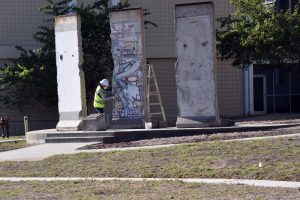By Cameron Binkley, DLIFLC historian, and Tammy Cario, Public Affairs

Dong Sun Kim, a local mural artist, cleans the three panels of the Berlin Wall on display at the Presidio of Monterey.
For the first time since acquiring three panels of the Berlin Wall nearly 20 years ago, the concrete pieces, currently on display at the Presidio of Monterey, are being cleaned and a preservative applied, a process meant to safeguard the fading graffiti.
The graffiti, created by anonymous artists expressing their opposition to the German Democratic Republic and the wall they built in 1961 to prevent East German citizens from escaping to a better life in the West, has been slowly fading after decades in the sun. The concrete has also been degrading. This cleaning and treatment will help stabilize the monument, though not restore the original color, which would be a more complex undertaking.
Dong Sun Kim, a local mural artist in Marina, California, is completing the work.

Dong Sun Kim, a local mural artist, cleans the three panels of the Berlin Wall on display at the Presidio of Monterey.
Detlev Kesten, Associate Provost at the Defense Language Institute Foreign Language Center, who helped locate Kim, has a personal connection.
“Having grown up during the Cold War era in West Germany, the Wall was a constant reminder that the two Germanys had been artificially divided, and that every effort needed to be made to bring the Wall down,” he said. “I consider myself fortunate to witness the fall of the Wall in 1989, and to see German unification become a reality during my lifetime.”
The three panels were donated to the Institute in 2005 by Walter Scurei. For the dedication ceremony, Peter Robinson, formerly President Ronald Reagan’s speech writer, delivered the keynote address. Robinson had penned the famous line spoken by Reagan at the Brandenburg Gate where he called upon the Soviet Premier, Mikhail Gorbachev, to “tear down this wall.”

The Berlin Wall for the dedication ceremony held November 2005 at the Presidio of Monterey.
“It is entirely fitting and proper that we have a memorial for our victory in the Cold War here at DLIFLC as our graduates played a key role in tearing down this wall,” said then-commandant Col. Tucker Mansager during the ceremony.
Some 33,000 Russian and another 16,000 German students completed the DLIFLC Basic Course during the Cold War era. Most of those graduates went on to serve at signals intelligence listening posts dotting the periphery of the Soviet empire, including at places like Field Stations Augsburg and Berlin or from air- and seaborne platforms. Reportedly, a half dozen DLIFLC graduates lost their lives because of the wall, including most notably, Maj. Arthur Nicholson who was shot by a Soviet sentry while conducting officially allowed observations in 1985, the last U.S. servicemember to be killed during the Cold War.
For the generations of students who have been or will be trained at DLIFLC since the end of the Cold War, the Berlin Wall Memorial serves to remind them of the critical role played by military linguists in preserving the security of the United States and its allies, the importance of persistent vigilance, the price of freedom, and the faith that victory is obtainable. Embedding the monument in the central quad of the DLIFLC campus ensures that thousands of students will be exposed to these ideas and in a more poignant and memorable fashion than any textbook could deliver.




